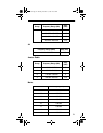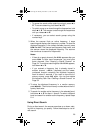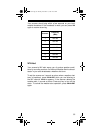
29
• To pause the search while receiving a signal, press
▲
or
▼
. To resume searching, hold down
▲
or
▼
.
• To quickly move up or down through the frequencies, hold
down
▲
or
▼
. The scanner tunes through the frequencies
until you release
▲
or
▼
.
• If necessary, you can select search groups using the
number keys.
3. When the scanner finds an active frequency, it stops
searching and displays the frequency’s number. To store the
displayed frequency in the lowest available channel, press
PGM
then
ENT
. The channel and frequency flash twice, and
the scanner stores the displayed frequency. The scanner
then continues to search for frequencies.
Notes:
• If there is no empty channel,
Ch-FULL
appears after you
press
PGM
. To store more frequencies, you must clear
some channels. See “Clearing a Stored Channel” on
Page 34. To continue searching after
Ch-FULL
appears,
hold down
▲
or
▼
.
• If you entered a frequency that is already stored in
another channel,
-dUPL-
(duplicate) and the lowest-
numbered channel containing the duplicate frequency
flash for about 3 seconds. If you want to store the fre-
quency anyway, press
ENT
again. You can then delete
the frequency later. See “Clearing a Stored Channel” on
Page 34.
4. To store the displayed frequency in a monitor memory,
press
MON/CL
. The monitor memory number,
M
, and the fre-
quency flash twice.
5. To search for another active frequency in the selected band,
hold down
▲
or
▼
for about 1 second. To select a different
band and search for another active frequency, repeat Steps
2–4.
Using Direct Search
During a direct search, the scanner searches up or down, start-
ing from a frequency you specify. Follow these steps to use di-
rect search.
20-314.fm Page 29 Monday, December 13, 1999 12:55 PM


















